�
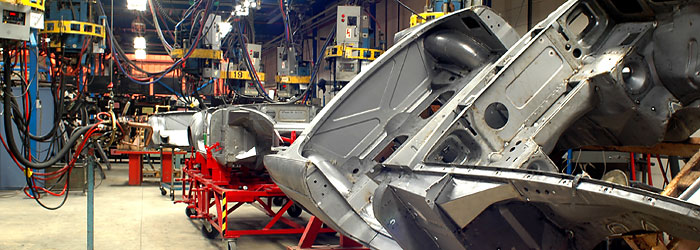
�
Touring "British Motor Heritage"
��
as published in British V8 Newsletter, Volume XV Issue 2, September 2007�
�
by: Curtis Jacobson�
Background Information
��
In 1975 British Leyland Motor Corporation formed a small division to provide technical �
information and genuine service parts for all the classic models of vehicles under �
its corporate umbrella. The "Leyland Historic Vehicles" division was charged with�
supporting both the British Motor Holdings side of the family tree (Austin, Morris,�
MG, Wolseley, Riley, Jaguar, Guy, and Daimler cars) and the Leyland Motors side�
(Triumph, Standard, Rover, and Alvis cars and utility vehicles plus Leyland�
trucks and buses.) For the sake of efficiency, the new division was managed from �
one centralized office.�
�
As an aside, it's interesting to note that Leyland Historic Vehicles gathered up a �
large collection of actual cars. Many of these cars were subsequently restored, and �
some of the division's expenses were funded by leasing cars for television, movie, and �
photographic uses. That part of Leyland Historic Vehicles ultimately evolved into �
The Heritage Motor Center museum at Gaydon.�
�
With the British automobile industry undergoing continuing turmoil and �
reorganization, Leyland Historic Vehicles became the British Motor Industry �
Heritage Trust ("BMIHT") in 1983. �
�
British Motor Heritage Ltd. was formed as the commercial ("parts") division of BMIHT, �
with a focus on body stampings and sub-assemblies off original factory tooling. �
Over the following years, British Motor Heritage operated as an autonomous subsidiary �
of The Austin Rover Group and its successors. (The Austin Rover Group was renamed �
Rover Group PLC in 1986, and was acquired by British Aerospace plc in 1988. In 1995 �
BMW bought the Rover Group from British Aerospace.) �
�
When BMW divested itself of Rover in 2000, British Motor Heritage wasn't included �
in the deal. BMW actually retained British Motor Heritage until November 2001, �
allowing veteran British automotive executives David Bishop, Neil Morrick, �
and John Yea to put together a financial takeover and management plan. �
�
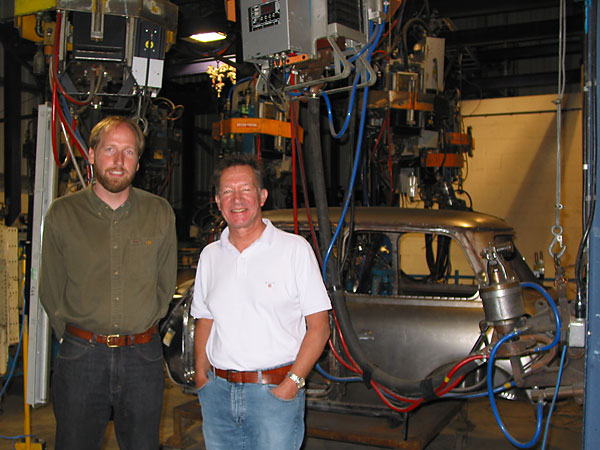
�
Chris Gardner (at right) of British Motor Heritage welcomed British V8 into their facilities in May 2007.�
British Motor Heritage Today
��
British Motor Heritage continues to be an independent, privately-owned, entirely-British �
company. In early 2006, David Bishop and Neil Morrick returned to retirement, leaving �
John Yea in managerial control. John Yea is also the majority shareholder in the company.�
�
British Motor Heritage is based in Witney, Oxfordshire (about 12 miles west of Oxford, �
14 miles northwest of Abingdon, and 65 miles west of downtown London.) Their staff �
of about 40 employees operates out of a single 51500 square foot building on a 3.6 �
acre site. This facility includes management, engineering, production and warehouse �
space. Steel stamping operations are outsourced, but assembly operations are done in �
house. �
�
BMH owns and maintains an archive of the original engineering drawings and specifications�
of BLMC vehicles and their predecessors. �
�
BMH also owns and maintains many of the original press tools and assembly fixtures for �
these vehicles. The oldest tools in their possession date back to about 1948, and are �
used to make service parts for Morris Minors. Some of the newest tools are used to make �
service parts for MG Rover Group vehicles such as the "MG TF" (which ceased production in �
2005, but recently restarted production in China and at Longbridge under new company �
ownership.) �
�
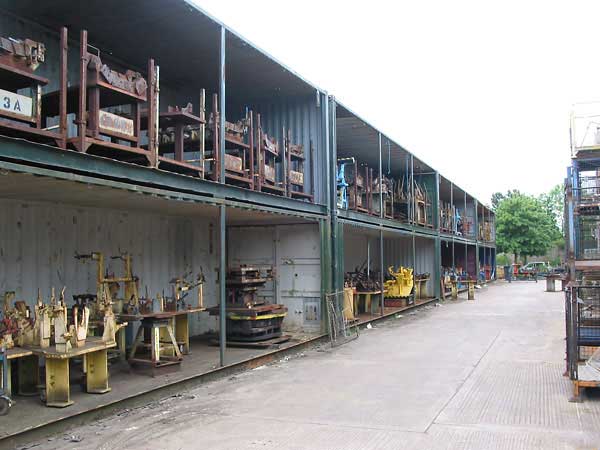
�
This photo shows a very small fraction of the original factory tooling maintained by British Motor Heritage.
�
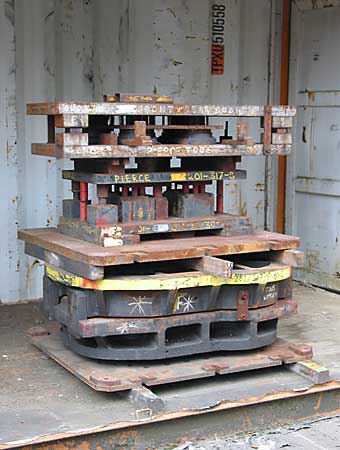 �
�
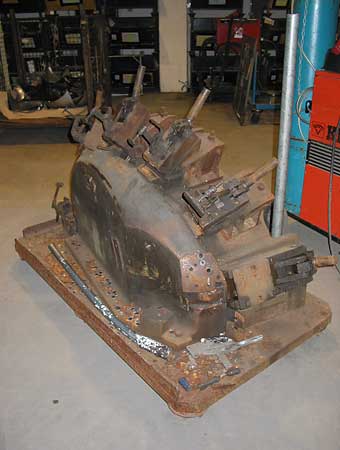
�
At left: three sets of pierce dies in storage. (These cut steel panels to size.)
�
At right: a Morris Minor tool that punches bolt holes around the edge of a fender.�
� British Motor Heritage's core business is the sale and manufacture of previously-unavailable � parts for classic British cars. BMH parts are exclusively distributed through a worldwide � network of "Heritage Approved Specialists". If you want a new, complete, and authentic steel � fender for an MGB (or a London taxi-cab for that matter), this is the place to get it! �
��
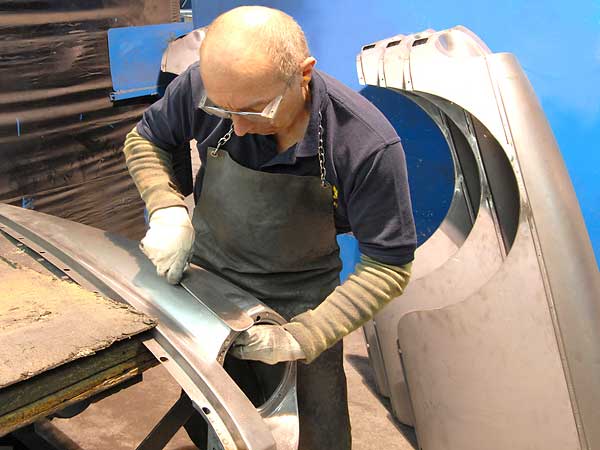
�
MG never expected MGB production to be so long-lived, so they didn't invest in more �
elaborate tooling
that would've saved handwork. Authentic MGB front fenders are made �
from 10 different pieces of steel.
Fine detailing of the fenders requires especially�
great skill.
�
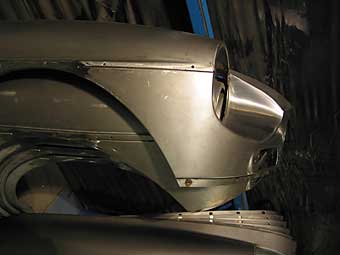 �
�
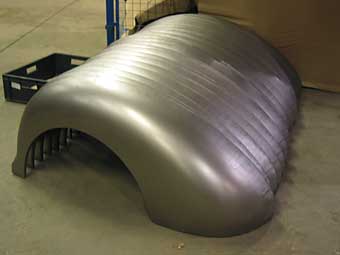
�
At left: a production run of chrome-bumper MGB front fenders, in process.
�
(There's a hidden weld in the headlamp bucket, where you see brighter metal.)
�
At right: a production run of MGA quarter panels.�
�
Some reproduction body parts for classic British cars are available from "knock-off" �
parts suppliers. It's very important to recognize that knock-off suppliers only cherry-pick �
the most profitable body and trim parts. If anything ever happens to British Motor Heritage,�
the knock-off suppliers won't be able to help you with harder-to-find parts. The continued �
success of BMH is important for the long term viability of our hobby. Buyer beware! Some of �
the major catalog parts suppliers offer cheap copies alongside genuine BMH parts. Before you �
buy, make sure to verify you're buying genuine parts. �
�
What if you only need a patch panel? British Motor Heritage is also the exclusive distributor�
of the UK-made "Steelcraft" range. What's the difference? The Steelcraft brand is known for �
economical patch panels that can be welded into larger assemblies for rust repair, etc. �
Steelcraft parts are manufactured in the UK by Taylor Pressform Ltd. Production started in �
1974, and about 400 different parts are currently produced. How can the number be that large? �
For one thing, Steelcraft also makes a lot of simple and less cosmetically important stampings �
(such as the backing plate for MGB front disc brakes.) Please note that Steelcraft parts are �
NOT made on original factory/production tooling. Steelcraft parts are clearly labeled �
"Steelcraft". �
�
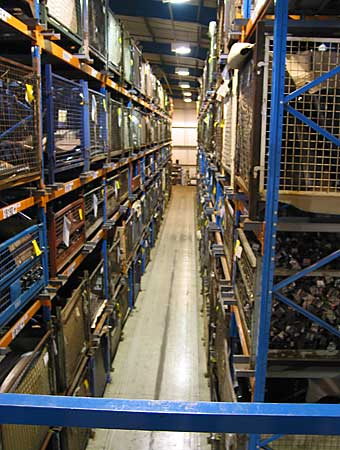 �
�
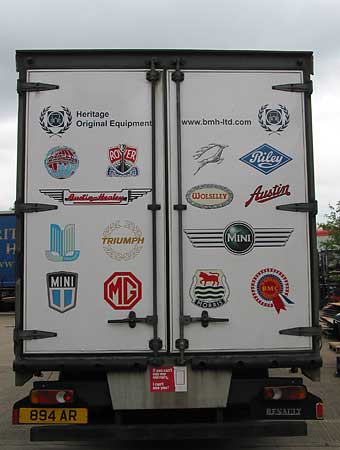
�
At left: just one aisle of British Motor Heritage's large parts warehouse.
�
At right: British Motor Heritage's parts operations keep this truck busy.�
�
British Motor Heritages's annual sales are in the ballpark of 4 million British pounds. �
Because the stamped parts they handle are only economical when produced in quantity, �
British Motor Heritage is obliged to carry a relatively large inventory. The value of their �
inventory averages about 2 million British pounds. The BMH manufacturing system currently �
lists about 10,000 different part numbers. �
�
British Motor Heritage is an ISO9001-2000 accredited supplier to Ford (for Jaguar and �
Land Rover parts).�
A Unique Mission
��
Whatever BMH is today should largely be credited to the visionary leadership of �
David Bishop, who began combing through the back lots of old BLMC facilities in �
the early 1980's to gather and collect old tooling. The preservation of old tooling �
has helped keep repair, restoration, and even building of "new" reproduction �
classic British sports cars feasible for enthusiasts. �
�
Although retired now, David Bishop's contribution as a "manufacturing guy" has been �
very important. His dedication to preserving the art and craft of old-school production �
techniques has been adopted and is being emulated by others. Furthermore, David Bishop's �
vision has not only kept old cars on the road, but also been crucial to keeping the �
British sports car hobby thriving. �
�
How has this affected our niche... specifically engine swappers? If it weren't still �
possible to purchase excellent MGB fenders brand new, competition for "parts cars" �
would be fierce and the supply of cars for engine swaps would be more expensive.�
�
On the other hand, engine swaps are becoming more refined, sophisticated, and higher-budget. �
Our cars now routinely sell for higher prices than pristine "original" and "restored" �
cars. Using brand new Heritage bodyshells has begun to make a lot of sense within our niche!�
�
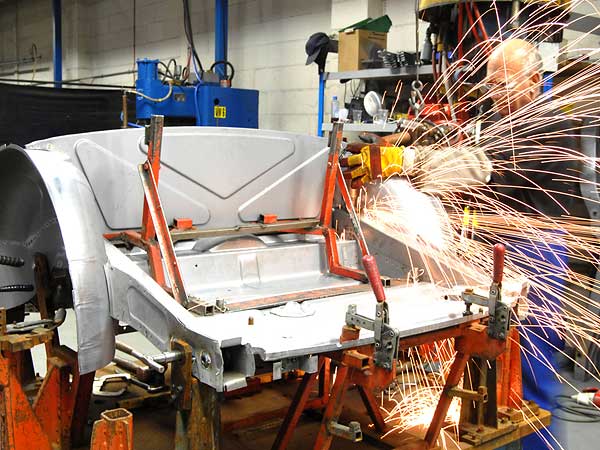
�
An MGB roadster bodyshell is being assembled on original factory fixtures.�
What is a Heritage Bodyshell?
��
In concept, the idea is deceptively simple: a Heritage bodyshell is a complete car body. �
It's a sheetmetal foundation that's ready to go to the paint shop, and then ready for all �
the mechanical, accessory and trim parts to be installed onto it. British Motor Heritage �
first introduced the MGB-roadster Heritage bodyshell back in 1988. Just pause for a �
moment and think about this:
Heritage bodyshells have been in production for longer �
than the original MGB was! �
�
Over the last eighteen years, Heritage bodyshells have evolved tremendously. The very �
definition of Heritage bodyshell has changed. Originally, the MGB unibody was provided �
without bolted-on body parts such as doors, hood ("bonnet"), and trunk lid ("boot lid"). �
The cost of procuring and installing these parts wasn't the issue... the problem was �
that fitting these parts wasn't a job for do-it-yourselfers. In the context of sixties-era �
automobiles, "fitting" frequently meant assertive use of a hammer. Probably the single �
most important improvement made to Heritage bodyshells is that all major panels are �
now pre-installed and aligned by experts who know just where to smack! �
�
Another obvious change from those early days has been the proliferation of distinct �
bodyshell variants. Shortly after the chrome-bumper roadster bodyshell was introduced, �
BMH followed with the GT model, and with rubber-bumper models. There were lefthand-drive �
variants versus righthand-drive variants. There were two-wiper (European spec) roadsters�
versus three-wiper (North American spec) roadsters. Pull-handle doors versus push-button �
doors... BMH even responded to requests for chrome-bumper shells with rubber-bumper �
underpinnings to provide roomier engine and tranny areas for engine swaps.�
�
MG Midget and Austin-Healey Sprite enthusiasts started calling... and Triumph TR6 �
enthusiasts... and classic Mini enthusiasts... not to mention the Rover factory with �
their RV8 program! BMH says that they currently build 42 distinctive bodyshell models. �
�
More importantly, BMH reports that "combined total production of bodyshells to date �
exceeds 6000 units" including MGB roadster and GT, MG RV8, MG Midget and A-H Sprite, �
Triumph TR6, classic Mini, and Mini Clubman. �
�
Let's take a step back and think about what's involved with making a Heritage bodyshell. �
First, BMH had to recover "lost" tooling from all around Britain. When the various car �
plants were shut down, tooling was scattered. Some of it remained with suppliers, but �
supplier facilities were shutting down too. Quite a lot of tooling went to scrap yards. �
Finding, identifying, purchasing and reconditioning old tooling was a major undertaking �
and investment. �
�
Perhaps you want a bodyshell built exactly to 1967 specs in every possible respect. �
Sorry, but that's not a realistic expectation. Here's why: running changes were made �
to the factory tools over time to accommodate ever changing production needs, model �
year specific features, changing requirements of various export markets, and changing �
option packages. So, if you're expecting an exact and specific combination of mounting �
holes and weld-nuts in your firewall, you very probably won't get it. Typically, a �
Heritage bodyshell will have a few extra mounting holes and/or weld nuts. This seems �
to be particularly true on earlier year-model cars.�
�
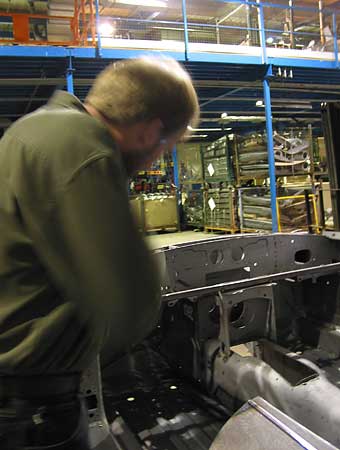 �
�
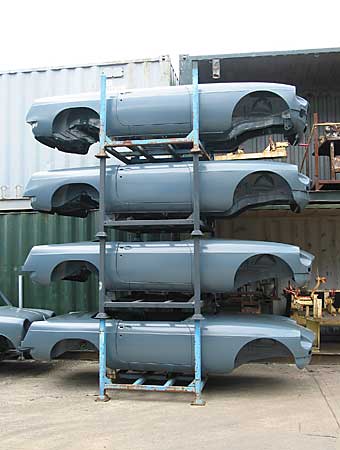
�
At left: Curtis inspects an incomplete MG RV8 bodyshell. Note the distinctive firewall and center console.
�
At right: MGB Heritage bodyshells back from being E-coated and primed. (The top one will have rubber bumpers.)
�
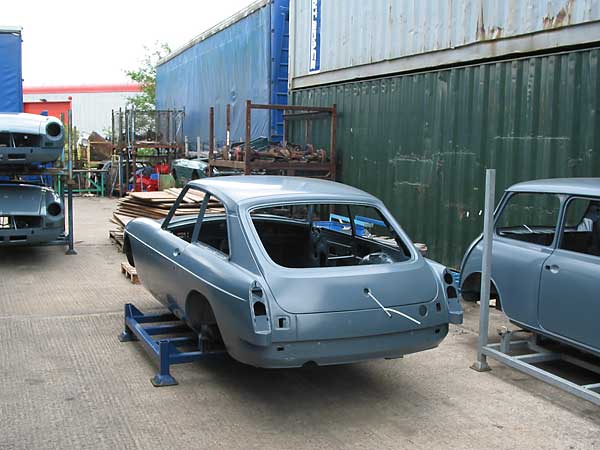
�
Heritage MGB-GT bodyshell. Fit of bolted-on body panels (like the GT hatch lid) is now carefully controlled.�
Are Heritage Bodyshells as Good as New?
��
In some respects, Heritage bodyshells are categorically superior to "original" bodies. �
The most obvious improvements are in the area of corrosion protection. All original �
BLMC bodyshells were stamped from plain carbon steel. To dramatically improve corrosion �
protection, British Motor Heritage began using galvannealed (NOT galvanized) zinc �
coated steel sheet for all MG bodyshells starting in 1993. �
�
Galvannealed steel is coated with zinc on both sides by a continuous hot-dip process. �
Immediately as the steel exits the coating bath, the molten zinc is subjected to an �
in-line heat treatment that converts the entire coating to a zinc-iron alloy. (Iron �
actually diffuses from the steel into the coating.) The surface typically has a matte �
finish that's very different from the dappled metallic appearance of a galvanized coating. �
At times, galvannealed coatings may appear similar to uncoated cold rolled steel.�
�
The zinc coating dramatically reduces rust in two ways: not only does it provide an �
additional barrier layer on the steel surface, but the zinc also functions as a �
sacrificial protector against galvanic corrosion. In other words, even if the zinc �
coating is scratched and salt water contacts the steel, the nearby zinc will tend to �
corrode instead of the steel. Galvannealed steel differs from galvanized steel in that �
the coating is thinner, harder, smoother and more even in appearance, more scratch and �
scuff resistant, and far preferable in terms of paint adhesion. Still, the galvannealed �
coating isn't a perfect solution. For one thing, the zinc coating is typically burned �
off around welds, the zinc coating doesn't cover die-cut panel edges, and it is subject �
to damage in press operations and part handling. �
�
To further improve corrosion resistance and provide a more consistent basis for paint, �
British Motor Heritage also sends all assembled bodyshells out for E-coating. �
"E-Coat" is a technology used worldwide for high-quality, low-cost, environmentally-friendly, �
corrosion protection. Approximately 98 percent of all automobiles produced �
worldwide are primed with E-Coat because of the exceptional corrosion protection �
it provides! �
�
E-coat should NOT be confused with powder-coating! The "E" in E-Coat indicates that �
the primer is deposited by completely immersing the bodyshell in an "electrophoretic" �
liquid paint emulsion. An electrical current is passed through the paint tank, causing the �
paint in contact with the metal bodyshell to adhere. The coating thickness is controlled �
by voltage adjustment. The current is typically only applied for about two minutes. (This �
is a subtle difference between E-coat and plating processes where coating thickness is�
controlled by amperage and especially by time.) The newly adhered paint blocks further �
deposition until an exceptionally even covering of paint is achieved. (The variation is �
typically 0.1 to 0.2 Mil, versus a thickness variation of 0.5 to 2.0 Mils for paint spraying �
techniques. Furthermore, spraying techniques tend to produce even less consistent �
protection on sheet metal edges, sharp corners, and recesses.)�
�
Heritage bodyshells have been E-coated since the start of production back in 1988. Since �
1993 all Heritage bodyshells have been E-coat primed after assembly, over top of their �
galvannealed zinc coating. �
�
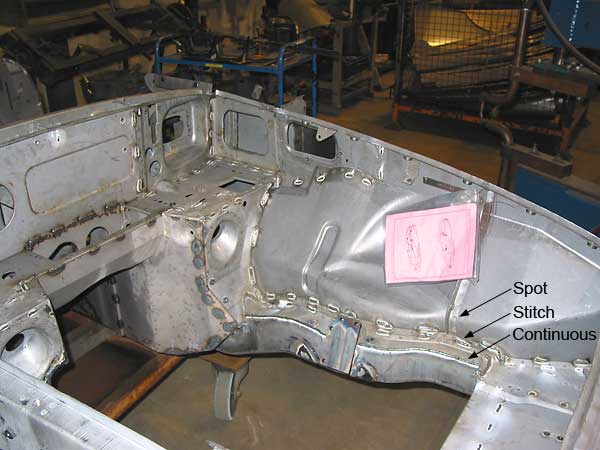
�
Want a stronger, stiffer bodyshell? British Motor Heritage now offers seam-welding before E-coat and paint. �
Stronger and Stiffer - The Competition Bodyshell Program
�� All of the classic BLMC models were built using spot welds and spot welds remain the � main welding technology for Heritage bodyshells, but there were always a few places � where the spot-welder electrode tips couldn't reach. (The welding equipment has to � reach both the front and back side of the joint at once.) Back in the day, oxy-acetylene � (flame) welding was used to weld these areas. Now, MIG electric arc welding is used � instead. MIG welding involves use of an inert gas to "shield" the weld area (i.e. to � avoid weld puddle contamination and to reduce splatter.) �
��
Enjoying this article? Our magazine is funded through the generous support of readers like you!
�
To contribute to our operating budget, please click here and follow the instructions.
�
(Suggested contribution is twenty bucks per year. Feel free to give more!)�
� British Motor Heritage's NEW "competition bodyshells" feature extensive MIG welding � that supplements the standard spot welds for significantly increased chassis stiffness, � strength, and crashworthiness. The Heritage competition bodyshell program also includes � an a la carte menu of optional features including: welded-in roll-cage mounting brackets, � precision-made roll-cages, reinforced mounting features for racing-type shoulder harnesses, � FIA-spec tow eyes, etc. See � Heritage Competition Bodyshells and Equipment� for detailed information.�
��
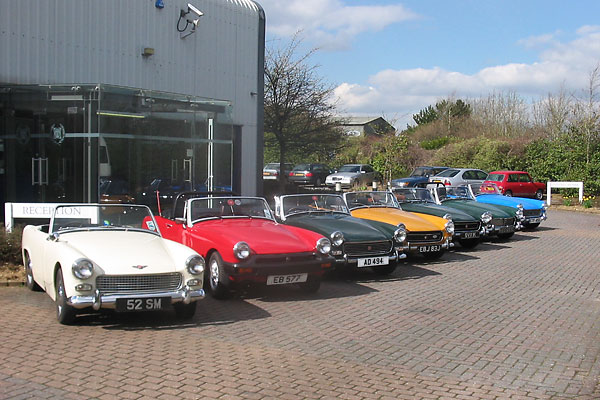
�
A Spridget Club Get Together at British Motor Heritage�
Austin Healey Sprite and MG Midget ("Spridget") Bodyshells
��
MGB fans sometimes forget a few facts about the little "Spridget" models, like that �
the MG factory at Abingdon had already produced over sixty thousand Spridgets before �
MGB production started in May 1962. That number includes all 48999 of the Mk.I �
(aka "bugeye" or "frogeye") Sprites. Their production run lasted from March 31, 1958 �
through January 1961. The Mk.II Sprite and Mk.I Midget were both launched in 1961.�
In 21 years and 8 months of production, almost as many Spridgets were built as MGB �
roadsters. Like the MGB, these little cars featured elegant, modern "unitbody" �
construction instead of frame-on-body construction. �
�
British Motor Heritage has collected up the original tooling, and has been building �
Heritage Spridget bodyshells since 1991. �
�
Are you curious to have a look? �
See photos�
of MG Midget bodyshells being built. �
�
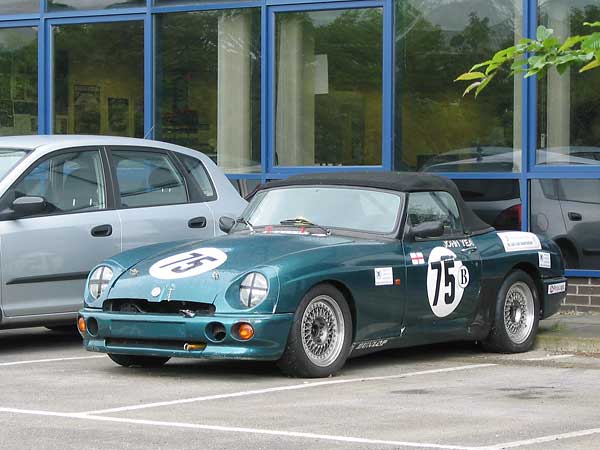
�
Managing Director John Yea's MG RV8 race car (parked outside British Motor Heritage)�
MG RV8
��
British Motor Heritage played a pivotal role in the design, development and production of �
one of the rarest and most prestigious MG models. In 1990, Rover Group became interested �
in reviving the MG badge on an upmarket, limited-production sports car as a precursor to �
introducing more mass-market models such as the MGF. Code named "Project Adder", Rover �
purchased a Heritage MGB bodyshell and began mocking-up in modeling clay a thoroughly �
updated design.�
�
Rover then contracted British Motor Heritage and Abbey Panels (famous supplier of hand-formed �
panels such as the original Jaguar XKE hood and the first Ford GT40 chassis) to bring concept �
to reality within a very modest development and tooling budget. British Motor Heritage would �
assemble the bodies for all RV8 cars.�
�
First shown publicly in October 1992, the MG RV8 was obviously stylistically derived from �
the MGB, except featuring a wider and stronger stance. The RV8 was critically acclaimed, �
despite its premium price. Rover was especially delighted by response to the car at the �
1993 Tokyo Motor Show. They wrote nearly 1300 orders! In fact, of the 2000 cars built, �
over seventy-five percent went to Japan. Rover assembled their final MG RV8 on November 22, �
1995 after having accomplished their public relations goal. �
�
Sadly for North Americans and mainland Europeans, Rover never even developed a left-hand-drive �
RV8, and at this time The British V8 Newsletter is only aware of three MG RV8 cars that have �
made it to North America. �
�
Although all 2000 of the MG RV8 production bodyshells were built by British Motor Heritage, �
Scott Miller's RV8 is unique because he actually started with an aftermarket bodyshell and �
built his own car! Actually, Scott's car is even more one-of-a-kind than that because he �
invested all the special skill and effort to create a left-hand-drive RV8. You can read more �
about it here:
�
Rare: Scott Miller's Unique Left-Hand Drive MG RV8, or here:
�
Photos of Scott Miller's 1994 MG RV8�
�
I guess it's small consolation to us now, but one of the best things about Rover's MG RV8 �
program is that it resulted in significant improvements to British Motor Heritage facilities.�
(I'm also happy about Rover's pioneering use of through-the-fender headers.) At this time �
the BMH isn't offering RV8 model Heritage bodyshells for sale. �
�
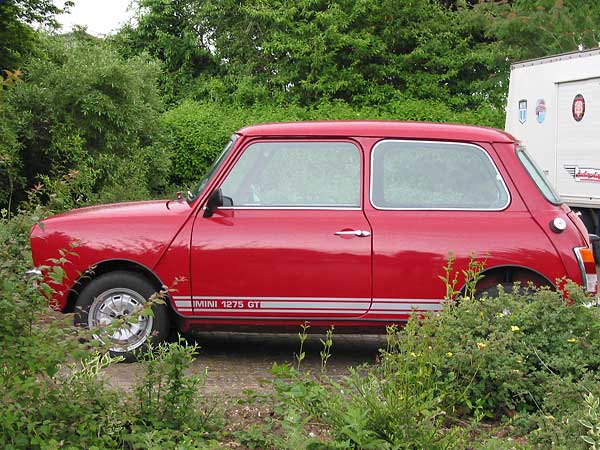
�
The Classic Mini and Mini Clubman models (including the "Mini 1275-GT") can be built from Heritage bodyshells. �
Classic Mini and Mini Clubman
��
Naturally, there's a great deal of interest in everything to do with Sir Alec Issigonis's �
brilliant little over-achiever. Like most "younger" North American's, I mostly know the �
Mini from Austin Powers movies... but those movies have really sparked my curiousity. �
In total, 5.4 million classic Minis were manufactured over forty-one years of production. �
That build was spread over factories in eleven different countries. However, considering �
the worldwide popularity of the Mini as an icon of the sixties, remarkably few classic �
Minis were ever brought to North America. �
�
BMH received the classic Mini tooling when production ended at Longbridge in 2000, and �
now Heritage Mini bodyshells are available in several interesting variants. �
�
"Be the change you want to see in the world." Wouldn't a Heritage Mini bodyshell be an �
excellent platform for your next project? High performance and great gas mileage? �
Heck, why not build yourself an electric car? Trade in your sport utility vehicle now.�
�
Another interesting but less obvious choice for your next hot-rod would be the Mini Clubman. �
The original Mini Clubman was produced from 1969 to 1980 in "saloon", "estate" (station �
wagon) and 1275-GT forms. (The 1275-GT version was a sub-variant of the saloon. It was �
the "performance package".) Strictly speaking, BMH only produces a Heritage bodyshell �
versons of the final-generation (1976-1980) Mini Clubman saloon. Although the Mini Clubman �
styling isn't universally popular, its larger engine bay suits installation of larger �
engines than a standard Mini. In England, hot-rodders frequently swap Honda VTEC, �
Vauxhall, or Rover K-series engines into the Mini Clubman. What would you put in your �
Mini Clubman? (Note: Clubman production totaled 626312 cars spread over eleven years of �
production. The breakdown was: 331675 saloons, 176688 estates, and 117949 1275-GTs.) �
�
Note: galvannealed steel is not yet included on the new Hertage Mini and Mini Clubman �
bodyshells models, although they do come with E-coat primer.�
�
What about Triumph TR6? For the time being, British Motor Heritage isn't accepting orders �
for Triumph TR6 Heritage bodyshells. They've produced a few... but production proved problematic �
because TR6 is a body-on-frame car. Even when BMH delivered a "perfect" TR6 bodyshell, there �
was no way to guarantee it would fit on a customer's (possibly tweaked) original TR6 frame. �
The TR6 bodyshells also proved especially susceptible to damage in shipping. If new aftermarket �
Triumph frames were available, BMH might consider marrying them to bodies and re-introducing �
the Heritage TR6 bodyshell.�
�
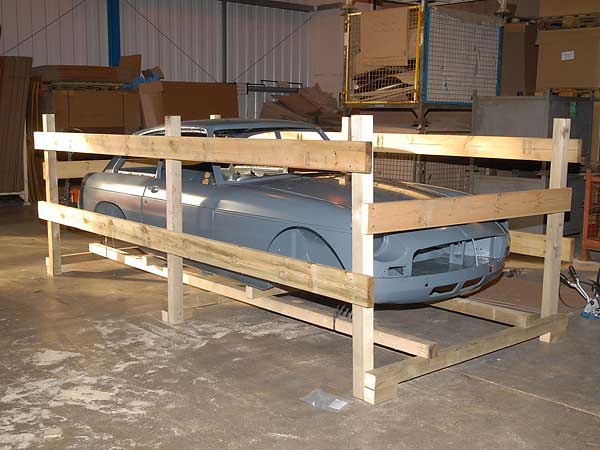
�
MGB-GT bodyshell being crated for shipment.�
Order Your Bodyshell Factory-Direct
��
Until recently, Heritage bodyshells were only available through "Heritage Approved Specialists". �
Beginning in late 2006, British Motor Heritage now offers factory-direct sales too. Obviously �
there's potential for dramatically improved efficiency, but another motivation is that direct �
communication improves customer satisfaction. �
�
British Motor Heritage prices their bodyshells in their local currency, "pounds sterling".�
They also add a 17.5 percent Value Added Tax ("VAT"). If you're purchasing a bodyshell for use �
outside the European Community, you may be able to get a refund of the value-added tax. �
�
Shipping cost is also additional, and will have to be quoted on a case-by-case basis. �
�
Purchasing a bodyshell by credit card is probably the easiest method. Check with your credit card �
company to determine current dollar-to-pound exchange rate and verify whether they have �
a surcharge on international purchases. (The credit card company's surcharge will probably �
be trivial. You could alternatively use an internation wire transfer, but the charge for �
that would be higher.) �
�
Bodyshells are available in many variants. Here is a sampling so that you can get an idea of �
what they currently cost.
�
Note: currency exchange rates vary daily. Don't despair - they're likely to improve for North American customers soon.
�
(Prices below were current as of September 1, 2007. Exchange rates were current on September 1, 2007.)�
| MODEL # | SPECIFICATION AND KEY FEATURES | G.B. POUNDS | U.S. DOLLARS |
| Popular MGB Variants | |||
| HZA4246 | 67-74 MGB roadster, USA spec | £ 4400 | $ 8880 |
| HZA5547 | 76-80 MGB roadster, USA spec | £ 4400 | $ 8880 |
| BMH4011 | "chrome-bumper" MGB roadster with V8 mods | £ 5100 | $ 10256 |
| HZA4248 | 67-74 MGB-GT, USA spec | £ 4750 | $ 9586 |
| BMH9010 | 74.5 MGB-GT, USA spec | £ 4750 | $ 9586 |
| HZA4251* | "chrome-bumper" MGB-GT with V8 mods | £ 5400 | $ 10859 |
| MG Midget | |||
| BMH8057 | Oct.66 - Aug.69 MG Midget (square wheel arch) | £ 3800 | $ 7669 |
| CZJ366 (& 203) | Aug.69 - Aug.71 MG Midget (square wheel arch) | £ 3800 | $ 7669 |
| CZJ83 (& 84) | Aug.71 - Oct.74 MG Midget (round wheel arch) | £ 3800 | $ 7669 |
| Popular Mini Variants | |||
| BMP0343 | 76-85 MkIV Mini | £ 3200 | $ 6458 |
| AAA360210 | 86-89 MkV Mini "sports pack" | £ 3200 | $ 6458 |
| CZH594 | 69-80 Clubman/1275-GT Mini | £ 3300 | $ 6660 |
| MGB "Competition Bodyshell" Options | |||
| ??????? | incremental charge for MGB seam welding | £ 750 | $ 1512 |
| ??????? | incremental charge for MGB roll-cage | £ 1500 | $ 3024 |
| ??????? | incremental charge for MGB FIA-spec tow-eyes | £ 100 | $ 202 |
| ??????? | incremental charge for MGB shoulder harness reinforcement | £ 95 | $ 192 |
| ??????? | incremental charge for MGB aluminum hood | £ 125 | $ 252 |
| ??????? | incremental charge for MGB aluminum deep front valance | £ 395 | $ 796 |
| ??????? | incremental charge for MGB fiberlass rear valance | £ 350 | $ 706 |
| ??????? | incremental charge for MGB baffled/foam-filled fuel tank | £ ??? | $ ??? |
| MG Midget "Competition Bodyshell" Options | |||
| ??????? | incremental charge for MG Midget seam welding | £ 750 | $ 1512 |
| ??????? | incremental charge for MG Midget roll-cage | £ 1400 | $ 2822 |
| ??????? | incremental charge for MG Midget FIA-spec tow-eyes | £ 100 | $ 202 |
| ??????? | incremental charge for MG Midget shoulder harness reinforcement | £ 95 | $ 192 |
| Mini / Mini Clubman "Competition Bodyshell" Options | |||
| ??????? | incremental charge for Mini seam welding | £ 750 | $ 1512 |
| ??????? | incremental charge for Mini roll-cage | £ 1400 | $ 2822 |
| ??????? | incremental charge for Mini FIA-spec tow-eyes | £ 100 | $ 202 |
� * : for HZA4251 you must specify left-hand drive, or you'll get right-hand drive.�
�
A ten percent non-refundable deposit is required with the initial order, and �
must be increased to a fifty percent payment before commencement of build. The �
remaining fifty percent payment is due upon receipt of the bodyshell.�
�
What about shipping cost? You'll need to call for a quote and work from there. The �
cost will very depending on your delivery location and on whether more than one �
bodyshell can be shipped over together. (Three crated MGB bodyshells, for example, �
will fit in a forty foot steel shipping container - but the cost to transport one �
container is the same whether it's full or empty. Heritage will be happy to �
consolidate shipments if they can.) Just for reference, to give you a conservative �
high-side shipping estimate, a customer recently paid $4800 for door-to-door transport �
of a GT bodyshell from Heritage to the buyer's house in Seattle Washington. In this �
case, the international transport charge wasn't shared at all. The cost of the �
wooden crate is £330 (about $667) + VAT.�
�
How long will it take? Heritage bodyshells are made-to-order, and they're made in �
batches. You'll need to check with Heritage to see when your bodyshell can be �
produced. Delivery time also needs to be quoted on a case-by-case basis. Just for �
reference, delivery from the port in England to Seattle Washington takes about �
twenty-five days. �
�
Disclaimer: This page was researched and written by Curtis Jacobson. Views expressed �
are those of the author, and are provided without warrantee or guarantee. Apply at your �
own risk.�
�
This article is part of a set of FIVE! If you enjoyed this article, check out:
�
BMH's Exciting New Competition Bodyshell Program
�
How BMH Built a Brand-New Vintage Race Car
�
The Building of an MG Midget Body
�
The Building of an MG MGB Body�
�
Photos by Curtis Jacobson for The British V8 Newsletter, except the first, sixth and eleventh photos�
from the top of the article, which remain property of British Motor Heritage and which are used by �
permission. The photo of Spridgets lined up outside BMH is by Steve Clark, and is used by exclusive �
permission. All rights reserved.�


